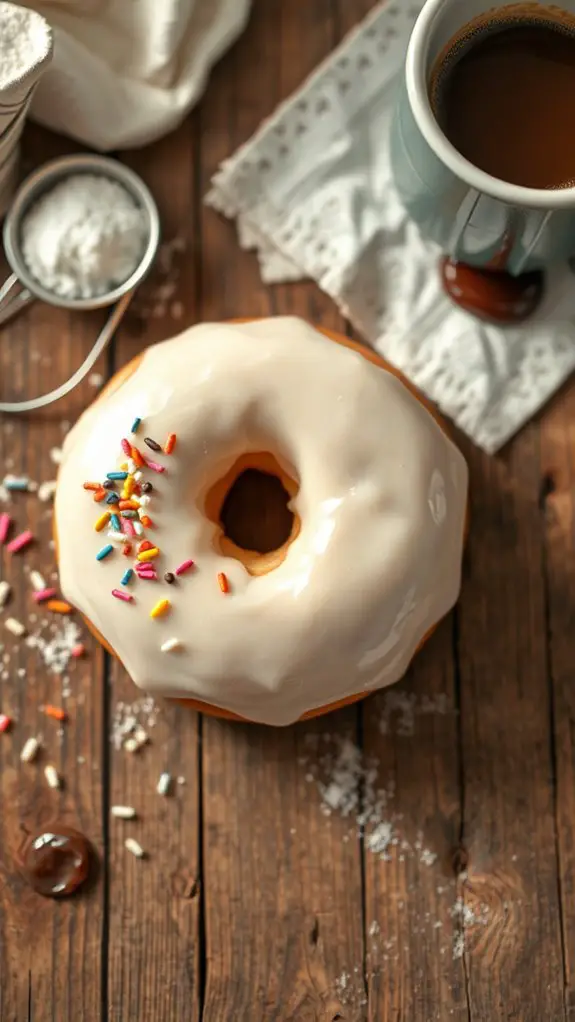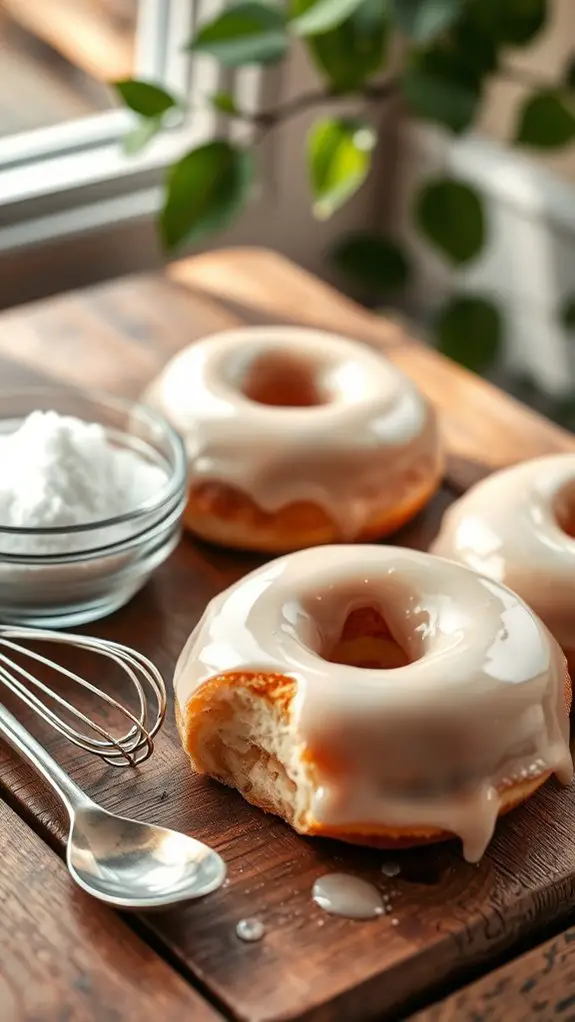You may have savored a soft, pillowy donut coated in a shimmering glaze, but have you ever wondered about its origins and evolution? From 17th-century Europe to global phenomenon, this sweet topping has captivated taste buds worldwide. Discover the secrets behind the perfect glaze, as well as the creative ways it can elevate your donut experience. Prepare to indulge in a mouthwatering exploration of this beloved confection.
History

Although the precise origins of the donut glaze remain obscure, historians trace its earliest incarnations to 17th-century European pastries.
The glaze's cultural significance evolved as it spread worldwide, with regional variations emerging to reflect local tastes and ingredients. In France, a rich egg-based glaze complemented delicate choux pastries, while British colonies experimented with fruit-infused coatings.
As the donut craze swept America, innovative glazes made from maple, chocolate, and fruit compotes arose, cementing the topping's place as an integral part of the beloved confection.
Today, the donut glaze's versatility continues to inspire bakers, from avant-garde flavor fusions to time-honored traditional recipes.
Recipe

Donut glaze is a sweet and shiny topping that can transform a plain donut into a delectable treat. The key to a perfect donut glaze is achieving the right balance of sweetness, consistency, and glossiness.
Whether you're making homemade donuts or looking to dress up store-bought ones, this recipe will guide you through the process of creating a mouthwatering glaze.
The glaze's versatility allows it to be customized to suit your personal preferences. You can experiment with different flavors, such as chocolate, maple, or citrus, by simply adjusting the ingredients. The result is a visually appealing and irresistibly delicious donut that will impress your friends and family.
- 2 cups confectioners' sugar
- 1/4 cup milk
- 2 tablespoons unsalted butter, melted
- 1 teaspoon vanilla extract
In a medium bowl, whisk together the confectioners' sugar, milk, melted butter, and vanilla extract until the mixture is smooth and free of lumps. The consistency should be thick but pourable.
If the glaze is too thick, add a teaspoon of milk at a time until you reach the desired consistency. Dip the tops of the donuts into the glaze, allowing the excess to drip off. Place the glazed donuts on a wire rack or parchment paper to set. For best results, allow the glaze to fully set before serving.
When making the glaze, be mindful of the temperature and humidity, as they can affect the consistency. If the glaze becomes too thick, you can thin it out with a small amount of milk.
Conversely, if it's too thin, add more confectioners' sugar. Experiment and find the perfect balance that works for your donuts.
Nutritional Guide
While the donut glaze recipe provides a delightful topping, it's important to take into account the nutritional aspects when indulging in these treats.
The caloric content of donut glaze can vary depending on the ingredient variations, such as the type of sugar, butter, or milk used. For instance, a glaze made with powdered sugar tends to be lower in calories than one made with honey or maple syrup.
Additionally, the portion size greatly impacts the overall nutritional profile. Moderation is key when enjoying these sweet delights, as the combination of carbohydrates and fat can quickly add up.
Final Thought
Savoring the donut glaze in moderation can be a delightful experience, as you'll relish the burst of sweetness without compromising your overall health.
Explore the myriad flavor variations, from classic vanilla to trendy matcha or lavender.
Revel in the cultural significance of the donut, a beloved comfort food that transcends boundaries.
Approach each bite mindfully, appreciating the interplay of textures and the way the glaze melts on your tongue.
Remember, the key lies in finding balance – indulge in the moment, but don't lose sight of your broader nutritional goals.
With a little self-awareness, the donut glaze can be a delectable treat, not a dietary downfall.

Donut Glaze
Equipment
- medium bowl
- Whisk
Ingredients
- 2 cups confectioners' sugar For sweetness and texture
- 1/4 cup milk Adjust for consistency
- 2 tablespoons unsalted butter Melted
- 1 teaspoon vanilla extract For flavor
Instructions
- In a medium bowl, whisk together the confectioners' sugar, milk, melted butter, and vanilla extract until the mixture is smooth and free of lumps. The consistency should be thick but pourable.
- If the glaze is too thick, add a teaspoon of milk at a time until you reach the desired consistency. Dip the tops of the donuts into the glaze, allowing the excess to drip off. Place the glazed donuts on a wire rack or parchment paper to set.
- For best results, allow the glaze to fully set before serving. Be mindful of the temperature and humidity, as they can affect the consistency. If the glaze becomes too thick, you can thin it out with a small amount of milk. Conversely, if it's too thin, add more confectioners' sugar.